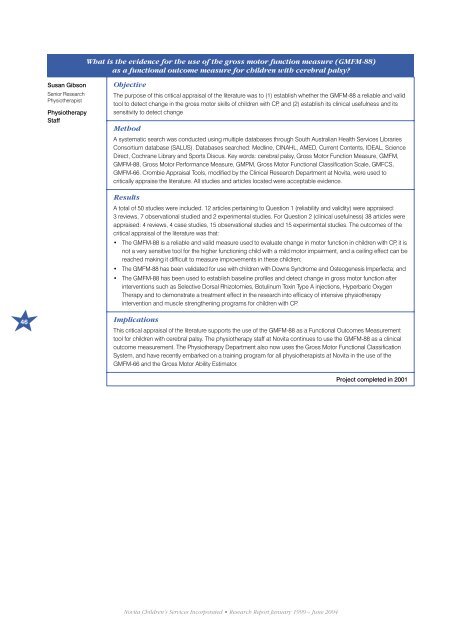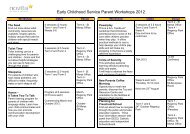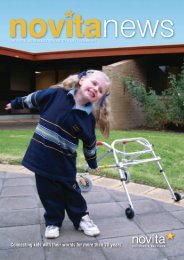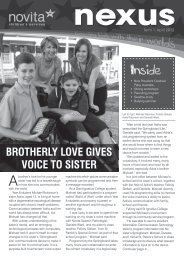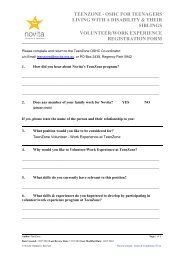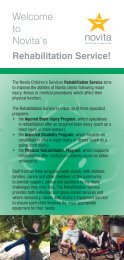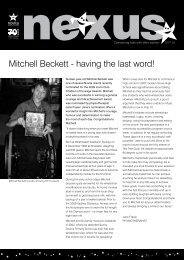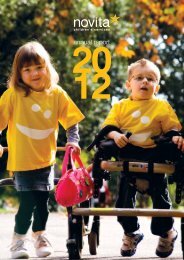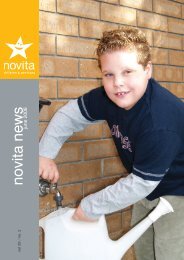Novita Research Report January 1999 - Novita Children's Services
Novita Research Report January 1999 - Novita Children's Services
Novita Research Report January 1999 - Novita Children's Services
You also want an ePaper? Increase the reach of your titles
YUMPU automatically turns print PDFs into web optimized ePapers that Google loves.
What is the evidence for the use of the gross motor function measure (GMFM-88)<br />
as a functional outcome measure for children with cerebral palsy<br />
Susan Gibson<br />
Senior <strong>Research</strong><br />
Physiotherapist<br />
Physiotherapy<br />
Staff<br />
Objective<br />
The purpose of this critical appraisal of the literature was to (1) establish whether the GMFM-88 a reliable and valid<br />
tool to detect change in the gross motor skills of children with CP, and (2) establish its clinical usefulness and its<br />
sensitivity to detect change<br />
Method<br />
A systematic search was conducted using multiple databases through South Australian Health <strong>Services</strong> Libraries<br />
Consortium database (SALUS). Databases searched: Medline, CINAHL, AMED, Current Contents, IDEAL, Science<br />
Direct, Cochrane Library and Sports Discus. Key words: cerebral palsy, Gross Motor Function Measure, GMFM,<br />
GMFM-88, Gross Motor Performance Measure, GMPM, Gross Motor Functional Classification Scale, GMFCS,<br />
GMFM-66. Crombie Appraisal Tools, modified by the Clinical <strong>Research</strong> Department at <strong>Novita</strong>, were used to<br />
critically appraise the literature. All studies and articles located were acceptable evidence.<br />
Results<br />
A total of 50 studies were included. 12 articles pertaining to Question 1 (reliability and validity) were appraised:<br />
3 reviews, 7 observational studied and 2 experimental studies. For Question 2 (clinical usefulness) 38 articles were<br />
appraised: 4 reviews, 4 case studies, 15 observational studies and 15 experimental studies. The outcomes of the<br />
critical appraisal of the literature was that:<br />
• The GMFM-88 is a reliable and valid measure used to evaluate change in motor function in children with CP, it is<br />
not a very sensitive tool for the higher functioning child with a mild motor impairment, and a ceiling effect can be<br />
reached making it difficult to measure improvements in these children;<br />
• The GMFM-88 has been validated for use with children with Downs Syndrome and Osteogenesis Imperfecta; and<br />
• The GMFM-88 has been used to establish baseline profiles and detect change in gross motor function after<br />
interventions such as Selective Dorsal Rhizotomies, Botulinum Toxin Type A injections, Hyperbaric Oxygen<br />
Therapy and to demonstrate a treatment effect in the research into efficacy of intensive physiotherapy<br />
intervention and muscle strengthening programs for children with CP.<br />
46<br />
Implications<br />
This critical appraisal of the literature supports the use of the GMFM-88 as a Functional Outcomes Measurement<br />
tool for children with cerebral palsy. The physiotherapy staff at <strong>Novita</strong> continues to use the GMFM-88 as a clinical<br />
outcome measurement. The Physiotherapy Department also now uses the Gross Motor Functional Classification<br />
System, and have recently embarked on a training program for all physiotherapists at <strong>Novita</strong> in the use of the<br />
GMFM-66 and the Gross Motor Ability Estimator.<br />
Project completed in 2001<br />
<strong>Novita</strong> Children’s <strong>Services</strong> Incorporated • <strong>Research</strong> <strong>Report</strong> <strong>January</strong> <strong>1999</strong> – June 2004


